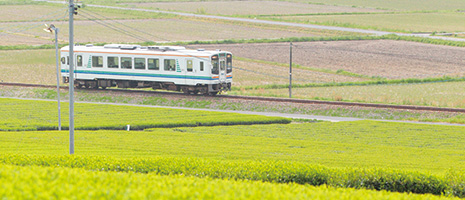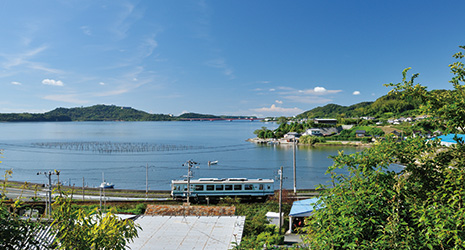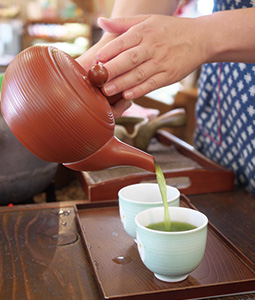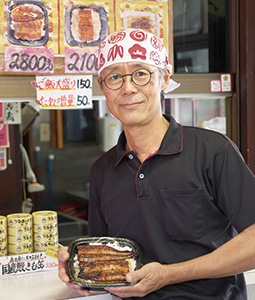Home > Highlighting JAPAN > Highlighting Japan July 2019 > A Trip by Local Train
Highlighting JAPAN


- PREVIOUS
- NEXT
The Train for Slow Life and Slow Food
Ride Tenryu Hamanako Railroad, which runs across Shizuoka Prefecture, and enjoy local specialties cultivated in a rich natural environment, such as tea and grilled eel, while relaxing in the calm, peaceful scenery.
Tenryu Hamanako Railroad, commonly known as the Tenhama Line, runs 67.7 kilometers through western Shizuoka, connecting Kakegawa Station, a Tokaido Shinkansen stop in Kakegawa City, to Shinjohara Station in Kosai City. It takes about two hours to travel the length of the Tenhama Line. Following a partial opening in 1935, the entire line opened in 1940. This railroad line is currently operated by Tenryu Hamanako Railroad Co., founded mainly by local governments along the line, including the Shizuoka prefectural government. One feature of the Tenhama Line is the thirty-six national registered tangible cultural properties, such as station buildings and bridges evocative of the time of its opening, that stand along the entire line, enabling passengers to indulge in nostalgia as they travel.
The Tenryu Hamanako Line takes its name from the Tenryu River, which begins in adjacent Nagano Prefecture and runs south across Shizuoka Prefecture, emptying into the Pacific, and Lake Hamanako, one of the largest Japanese brackish lakes. The areas along the line are surrounded by abundant nature and there are many scenic spots where beautiful flowers, such as plum blossoms, hydrangeas and Japanese bellflowers, can be viewed in their full glory.
Yoshiji Omura, Administration Manager of Tenryu Hamanako Railroad, says, “If you take the Tenhama Line, you can enjoy a relaxing trip enjoying the variety of local agricultural products and seafood, as well as feast your eyes on the natural scenery.”
One of Shizuoka Prefecture’s specialties is tea. In this prefecture, where tea cultivation began to spread in the Edo period (1603–1867), unused lands were developed into tea fields on a large scale in the Meiji period (1868–1912) and the prefecture became a major Japanese tea producer. As of 2017, the prefecture was nationally top ranked in cultivated area and production. From Kakegawa Station, you can take a train ride through the countryside, and in about 30 minutes, tea fields will come into view from the windows and you will reach Totomi-Ichinomiya Station in Mori-Machi, one of many production centers in the prefecture. Nestled in low hills, Mori-Machi is home to numerous tea factories, retail stores and Japanese-style confectionery stores. Ota Chaten manufactures and sells teas using leaves picked in selected tea fields and you can enjoy free samples. At the café in the store, you can also enjoy sweets, including Japanese-style confections and cakes made using the tea leaves.
“The taste of tea differs with the tea field and according to how long it has been left to stand after harvesting. Considering these differences in taste, we provide the most delicious tea for each season, all year round,” says Eiko Ota, the store’s manager.
The town of Mikkabi, on the shores of Lake Hamanako, is known as a major mandarin orange producer. From the windows of the Tenhama Line, you can enjoy the beautiful view of the orchards bearing mandarin oranges from October to December. You can disembark and pick mandarin oranges at a number of sightseeing orchards along the line.
Many of the Tenhama Line’s thirty-nine stations have restaurants serving delicious food inside the station buildings. At Guriru Yagumo inside the Nishi-Kiga Station building, a national registered tangible cultural property built in 1938, you can enjoy French cuisine made with locally grown vegetables. At Granny’s Burger & Café inside Mikkabi Station, whose building is also a registered tangible cultural property, hamburgers using locally produced beef are popular. Yamayoshi, a Lake Hamanako grilled eel restaurant, operates in Shinjohara Station, the Tenhama Line’s terminal.
Japanese eel cultivation began from a culture pond that was made on Lake Hamanako in the late nineteenth century. Eel fry inhabited Lake Hamanako in large numbers. There was an abundance of underground water necessary for cultivation on the shores of the lake, and the Lake Hamanako area became a major cultivated eel producer. Tadayoshi Yamada, the manager of Yamayoshi, was the third-generation manager of an eel cultivation business handed down from his grandfather, and, during his boyhood, helped cultivate eels. The company started to sell grilled eels at stations in 1990 and now customers come all the way from different areas all across the country. In 2000, they withdrew from the eel cultivation business, but still always serve locally produced eels at the restaurant. There is only space for ten customers in the restaurant, but take-out is available, so many customers eat grilled eel boxed lunches on the train.
“Running a restaurant at the station, I feel like I am connected to people all over the country through the railroad. I always like to serve the most delicious locally produced grilled eel for customers who have come all the way from distant places,” says Yamada.
If you travel on the Tenhama Line, you will enjoy the satisfying blessings of nature and the natural scenery.
- PREVIOUS
- NEXT
© 2009 Cabinet Office, Government of Japan









